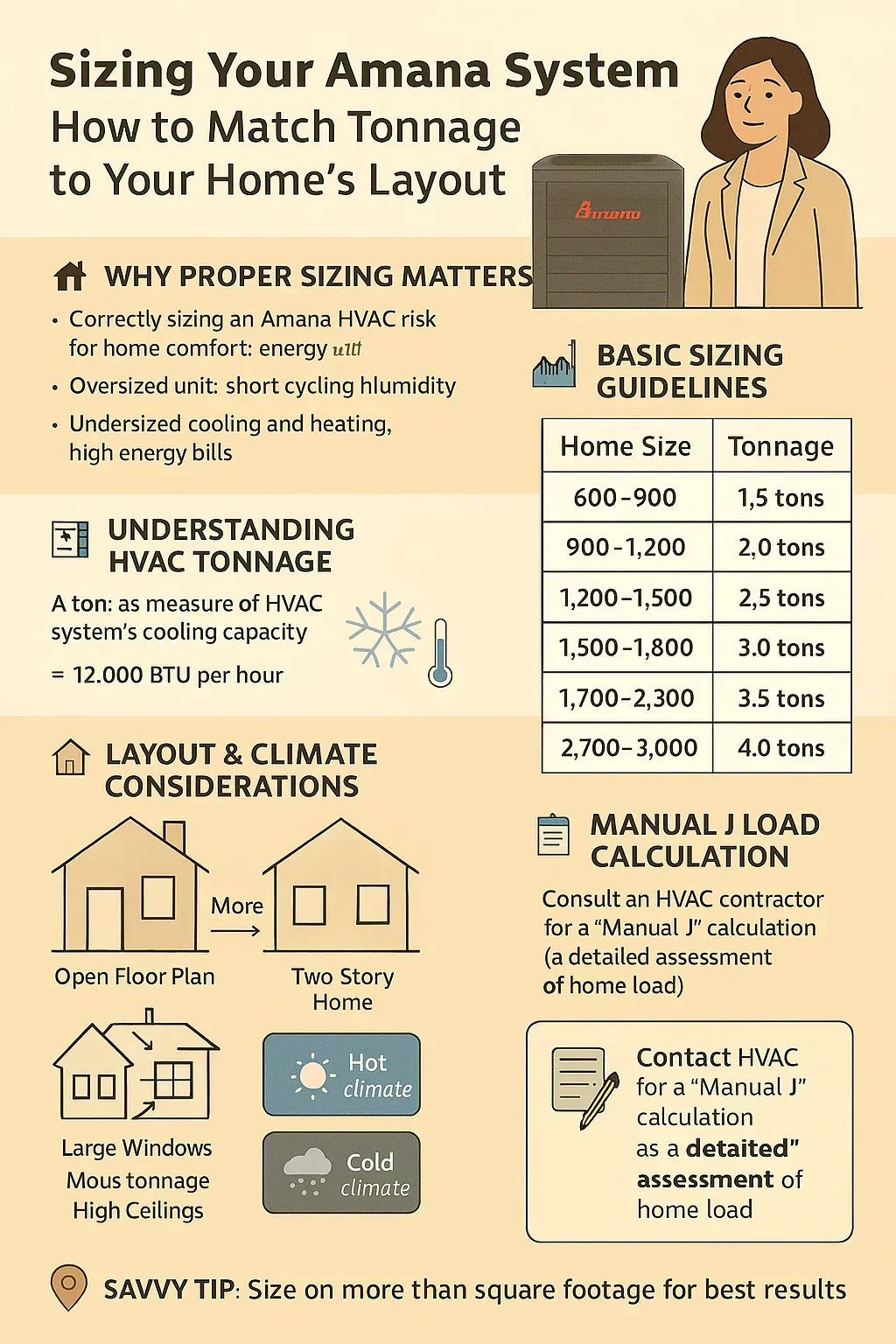🏠 Introduction: Why Proper Sizing Matters
When it comes to HVAC systems, bigger is not always better. An Amana system that’s too large for your home will short-cycle, wasting energy and struggling to control humidity. Too small, and it will run constantly, wearing out early and still failing to keep you comfortable.
Getting the right size — measured in tonnage — is one of the most important steps in an HVAC purchase. It affects:
-
Comfort: even temperatures, humidity control
-
Efficiency: lower energy bills
-
System longevity: fewer repairs, longer lifespan
This guide walks you through what tonnage means, how to estimate your needs, why layout matters, and how to make sure your Amana system is perfectly matched to your home.
📏 Understanding HVAC Tonnage
What Does “Tonnage” Mean?
In HVAC, tonnage measures the system’s cooling capacity — not its weight.
-
1 ton = 12,000 BTUs of cooling per hour
-
Residential central systems usually range from 1.5 tons to 5 tons.
BTUs and Square Footage
A common baseline:
-
1 ton per 500–600 sq. ft. in a typical U.S. home.
But this is just a starting point — climate, insulation, windows, and layout can change the requirement significantly
How SEER2 Ratings Interact with Sizing
A high-efficiency system (like Amana’s 24.5 SEER2 AVXC20) may reduce your utility bills, but efficiency alone doesn’t change the actual tonnage you need. Sizing is about load requirements; efficiency is about how much energy the system uses to meet them.
📊 Basic Sizing Guidelines
| Home Size (sq. ft.) | Approx. Tonnage | BTUs Needed |
|---|---|---|
| 600–900 | 1.5 tons | 18,000 |
| 900–1,200 | 2.0 tons | 24,000 |
| 1,200–1,500 | 2.5 tons | 30,000 |
| 1,500–1,800 | 3.0 tons | 36,000 |
| 1,800–2,100 | 3.5 tons | 42,000 |
| 2,100–2,400 | 4.0 tons | 48,000 |
| 2,400–2,700 | 4.5 tons | 54,000 |
| 2,700–3,000 | 5.0 tons | 60,000 |
(Adapted from The Furnace Outlet Sizing Guide and ACCA Manual J guidelines)
🏡 Layout Considerations
Open-Concept vs. Segmented Floor Plans
-
Open-concept homes: Air moves freely, so a properly sized system can cool the space evenly.
-
Segmented or closed-off layouts: May require zoning or multiple air handlers to prevent hot/cold spots.
Multi-Story Homes
Heat rises — upper floors often need more cooling. A 2-story 2,000 sq. ft. home might need zoning or a variable-speed system to balance floors effectively
Homes with Large Windows or Vaulted Ceilings
-
South- or west-facing glass increases cooling load.
-
High ceilings increase air volume that must be conditioned.
🌦 Climate & Regional Factors
Hot/Humid Climates (e.g., Florida, Texas)
-
May need more cooling tonnage per sq. ft. than the national average.
-
Humidity control is key — consider Amana’s variable-speed systems for longer run times at lower speeds
Cold Climates (e.g., Minnesota, Maine)
-
Cooling demand is lower; heating may be the primary driver for sizing.
-
Heat pump sizing often balances heating load vs. cooling load.
Mixed Climates (Midwest, Mid-Atlantic)
-
Balanced sizing is essential — oversizing for summer can leave winters less efficient.
🔍 Why a Manual J Load Calculation Is Key
A Manual J calculation is the industry standard for determining exact HVAC size. It factors in:
-
Square footage
-
Insulation quality
-
Window size and orientation
-
Number of occupants
-
Local climate data
You can request one from your licensed Amana dealer
📌 Savvy Tip: Never size an HVAC system based solely on your old unit’s capacity — your home’s efficiency may have changed.
⚠ Risks of Improper Sizing
Oversizing
-
Short cycling → more wear and tear
-
Poor humidity control
-
Higher energy bills
Undersizing
-
Constant running → higher utility costs
-
Uncomfortable hot/cold spots
-
System strain and shorter lifespan
✅ Matching Amana Models to Your Needs
Small Homes or Apartments (1.5–2.0 tons)
-
Amana ASX13 (entry-level SEER2) or ASXC16 (two-stage for comfort)
Mid-Sized Homes (2.5–3.5 tons)
-
Amana ASXC16 or AVXC20 for higher efficiency and ComfortBridge™ controls
Large Homes (4.0–5.0 tons)
-
Amana AVXC20 variable-speed for precise load matching
(See The Furnace Outlet – Amana Collection)
🛠 Installation & Ductwork Considerations
Even the right-sized Amana system will underperform if ductwork is:
-
Too small (restricting airflow)
-
Leaky (losing cooled or heated air)
-
Poorly insulated (especially in attics or crawl spaces)
A professional should perform duct leakage testing before installation (EnergyStar Duct Sealing Guide).
📌 Savvy Takeaway
The perfect Amana system for your home isn’t just about picking a SEER2 rating or model — it’s about matching tonnage to your home’s unique layout, climate, and insulation profile.
Your steps to success:
-
Start with a square footage estimate.
-
Factor in layout, ceiling height, and window load.
-
Adjust for climate region.
-
Get a professional Manual J calculation.
-
Choose the Amana model that meets your exact load while offering the features you want.
When sized correctly, your Amana system will run efficiently, last longer, and keep you comfortable year-round.
In the Next topic we will read more about: What’s New in Amana’s 2025 HVAC Lineup? Features, SEER2 Ratings & Upgrades







